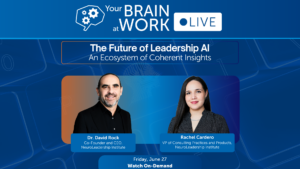With a fresh focus on improving performance and increasing inclusion in the public sector, government leaders face more decisions on how to approach telework in a VUCA (volatility, uncertainty, complexity, and ambiguity) world. While legislation could provide some guidance to leaders of the nation’s 2.1 million federal employees spread across law enforcement, diplomatic functions, education, the military, and more, public sector leaders still don’t fully know the impact of the pandemic on the future of work.
So, how does the public sector continue to do its critical work and safeguard the population while identifying best practices of telework and optimizing change efforts?
Use employee motivation to your advantage
In times of change and experimentation, NLI’s research suggests leaders should be maximizing employees’ sense of certainty, autonomy, and relatedness to make public agencies highly productive and help employees adjust to new processes in telework.
These three domains come from NLI’s SCARF® Model of social threat and reward, which captures five areas in which humans tend to feel motivated or demotivated. Those domains include status, certainty, autonomy, relatedness, and fairness. The middle three, in particular, tend to be missing during times of change — we feel uncertain, helpless, and alone.
With that in mind, public sector leaders can focus on these three domains to make teleworking life a bit more manageable by:
- Fostering regular connections. The more people adapt to working remotely, the stronger the need for engagement. If you manage people who spend most of the day dispersed and siloed, try scheduling regular meetings or check-ins through video chat and creating explicit team goals to create alignment and relatedness.
- Modeling autonomy. For government officials looking to get back to the rigidity of a strict schedule, try to model and encourage flexibility and autonomy where possible. Let people know that just because school closures aren’t happening as frequently, they still have some autonomy in their day if needed and may not need to always follow a rigid 9-to-5 schedule.
- Addressing career path concerns. For those concerned that they won’t be considered for promotions if they aren’t seen regularly, look to provide ways to give people the certainty that their outcomes and performance will be recognized fairly no matter where they work.
Benefits that last
In each of these cases, it’s important to communicate directly and often, so people can feel as empowered, acknowledged, and certain as possible. We don’t yet know what the data will show about performance and inclusion in public sector telework, but there’s a good chance process improvement will continue and experimentation to find best practices will be encouraged.
Government leaders who acknowledge this and work to foster autonomy, certainty, and relatedness in the meantime will be much more successful than those who expect to return to former ways of working. And with any luck, teams will accomplish more during this next chapter of the way we work and foster healthier work habits that will carry over into more innovative, collaborative, and productive government outputs.






